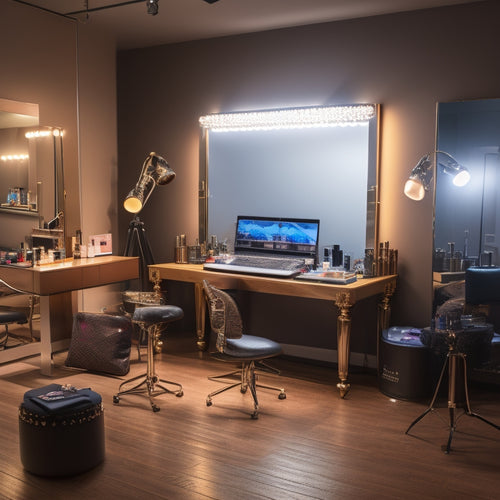
Manifesto Exhibition: A Theatrical Artistic Journey
Share
As I stepped into the Hamburger Bahnhof Museum, I was immediately immersed in Julian Rosefeldt's ambitious project, Manifesto, where thirteen short films featuring Cate Blanchett breathed new life into the traditional manifesto form, transforming it into a multimedia spectacle that probes the essence of artistic declarations. The exhibition's unique layout and architecture perfectly complement the films, creating an industrial and artistic atmosphere that draws me in. With each film, I'm struck by the nuanced exploration of art, politics, and culture, and I begin to question the fabric of reality. As I navigate this theatrical artistic journey, I sense there's more to uncover.
Key Takeaways
• Julian Rosefeldt's Manifesto exhibition is a multimedia spectacle that reexamines the manifesto as an artistic and cultural phenomenon.
• The exhibition features 13 short films starring Cate Blanchett, blurring art, performance, and film to create a cohesive narrative.
• Hamburger Bahnhof Museum's unique architecture provides an industrial and artistic atmosphere, perfectly suited for Rosefeldt's exploration of manifestos.
• The exhibition explores the power of artistic declarations, questioning the fabric of reality and challenging viewers' understanding of art, politics, and culture.
• Through its multilayered narrative, Manifesto contemplates the evolution of a revolutionary form, from collective action to individualism, and its impact on art history.
Julian Rosefeldt's Vision Unfolds
Through Manifesto, Julian Rosefeldt orchestrates a multimedia spectacle that presents a radical reexamination of the manifesto as an artistic and cultural phenomenon.
As I navigate the exhibition, I'm struck by Rosefeldt's bold artistic transformations, which breathe new life into the traditional manifesto form. The thirteen short films, featuring Cate Blanchett in various roles, are a masterclass in theatrical exploration, blurring the lines between art, performance, and film.
Each film is a self-contained world, yet together they form a cohesive narrative that probes the very essence of the manifesto. Rosefeldt's vision unfolds as a nuanced exploration of the intersections between art, politics, and culture, inviting viewers to question the role of manifestos in shaping our understanding of the world.
A Museum Like No Other
As I step into the Hamburger Bahnhof Museum, the decommissioned railway station's imposing architecture envelops me, its tunnel-like exhibition space perfectly suited to house Julian Rosefeldt's unconventional exploration of the manifesto.
The museum's unique layout, with its retained train station features, creates an atmosphere that's both industrial and artistic. The grand, arched ceilings and expansive spaces evoke a sense of awe, making it an ideal setting for Rosefeldt's ambitious project.
As I navigate the exhibition, I'm struck by the way the museum's architectural wonders complement the films, allowing the viewer to fully immerse themselves in the world of manifestos. The Hamburger Bahnhof's transformation from a functional train station to a hub of artistic innovation is a reflection of the power of repurposing and creative vision.
Themes and Influences Unraveled
Twelve distinct characters brought to life by Cate Blanchett's chameleon-like performances anchor Manifesto, each one embodying a unique worldview that Rosefeldt masterfully weaves together from a diverse tapestry of influences.
As I explore further into the exhibition, I notice the subtle yet powerful presence of Marxist influences, echoing the revolutionary spirit of collective action. The Dadaist aesthetics, reminiscent of Tristan Tzara's provocative manifestos, add a layer of avant-garde experimentation to the narrative.
-
Industrial landscapes: Rosefeldt's use of stark, industrial backdrops evokes a sense of grittiness and rebellion.
-
Vintage typography: The exhibition's incorporation of distressed, vintage-inspired typography adds a layer of nostalgia and historical depth.
-
Disjointed montages: The rapid-fire editing style creates a sense of disorientation, mirroring the fractured nature of modern society.
Through these influences, Rosefeldt masterfully crafts a complex, multilayered narrative that invites the viewer to question the very fabric of our reality.
The Power of Artistic Declarations
Examining the historical significance of artistic declarations, I find that manifestos have consistently served as catalysts for innovation and disruption in the art world. They have empowered artists to challenge the status quo, articulate their vision, and assert their creative expression.
| Artistic Movement | Key Manifesto | Impact |
|---|---|---|
| Cubism | Du "Cubisme" (1912) | Shaped modern art's visual language |
| Surrealism | The Surrealist Manifesto (1924) | Redefined the boundaries of reality and fantasy |
| Futurism | The Futurist Manifesto (1909) | Celebrated the dynamism of modern life |
Through these declarations, artists have been able to tap into the power of collective action, sparking movements that have reshaped the art world. By examining the power of artistic declarations, we can gain insight into the role of manifestos in driving creative innovation and shaping the course of art history.
Evolution of a Revolutionary Form
I find myself questioning whether manifestos, once powerful catalysts for innovation, have retained their revolutionary edge over time, or if they've become antiquated relics of a bygone era. As I explore the world of manifestos, I'm struck by the evolution of this revolutionary form.
Here are three key aspects that come to mind:
-
From collective action to individualism: Manifestos have shifted from calling for collective action to embracing individuality, as seen in movements like BLAST.
-
Changing societal dynamics: Manifestos reflect the changing societal dynamics over time, adapting to new contexts and challenges.
-
Cooptation and commercialization: The rhetoric of manifestos has been coopted by capitalist interests, diluting their original intent and impact.
As I navigate this evolution, I'm left wondering: Can manifestos still drive artistic transformation, or have they lost their revolutionary declarations in the process?
Frequently Asked Questions
How Long Do Visitors Typically Spend at the Manifesto Exhibition?
"When in Rome, do as the Romans do," I think, as I ponder how long visitors typically spend at the exhibition. On average, they engage with the 13 short films for about 2-3 hours, fully immersing themselves in the artistic journey.
Are the Short Films Available to Stream Online After the Exhibition?
I'm curious if the short films will be available to stream online after the exhibition; unfortunately, I couldn't find any information on post-exhibition viewing options, leaving me wondering about the online accessibility of these unique films.
Can Visitors Take Photos or Videos During the Exhibition?
As I step into the dimly lit tunnel, I'm struck by the anticipation. But, no, I won't be capturing this experience - photography and videos are not allowed during the exhibition, and I must respect the rules, surrendering to the art.
Are the Printed Text Catalogs and Scripts Available for Purchase?
I wonder if I can take a piece of the exhibition home; the printed text catalogs and scripts would make great memorabilia, but I'm unsure if they're available for purchase, possibly as merchandise or souvenirs online.
Are There Guided Tours or Audio Guides Available for the Exhibition?
As I navigate the exhibition, I wonder if guided tours or audio guides are available to enhance my understanding of the complex themes and artistic movements on display, providing a more profound exploration into the world of manifestos.
Related Posts
-

Elevate Your Dance Makeup Business Online
You're one step away from taking your dance makeup business global. A professional online presence is key, with 75% o...
-

Dazzling Ballet Ticket Unveiled
The anticipation is over, as the dazzling ballet ticket design has finally been revealed, exuding elegance and sophis...

